 Provinces Provinces |
Administratively, the country is divided into 18 provinces, each unique and each with their particular climate, culture, traditions and even language.

Capital: Caxito
Area: 33.016 km2
Population: 300.000 inhab.
City councils: 5 - Dande, Ambriz, Icolo and Bengo, Muxima, Hambuangongo
Climate: Dry Tropical
Agriculture: Cotton, manioc, palm trees , citrines, farm products
Minerals: sulphur, mineral salt, phosphate, quartz
Other Products: fish

Capital: Benguela
Area: 39.826.83 km2
Population: 1.400.000 hab.
City councils: 9 - Lobito, Bocoio, Balombo, Ganda, Cubal, Calmbambo, Benguela, Baía Farta, Chongoroi
Climate: temperate (mild)
Agriculture: Bananas, Sugar, Cotton, Vegetables and Corn
Minerals: Mineral Industry
Other Products: Fishing Industry

Capital: Kuito
Area: 70.314 km2
Population: 790.000 hab.
City Councils: 9 - Kuito, Andulo, Nharea, Cuemba, Cuhinga, Catabola, Camacupa, Chinguar, Chitembo
Climate: Tropical of Altitude
Agriculture: Citrines, Rice, Beans, Corn, Sisal, Banana
Minerals: Kaolin, Iron, Manganese, Radioactives Minerals.

Capital: Menongue
Area: 199.049 km2
Population: 140.000 hab.
City Council: 9 - Menongue, Cuito Cuanavale, Cuchi, Cuangar, Longa, Mavinga, Calai, Dirico, Rivungo
Climate: Tropical of Altitude / Dry
Agriculture: Massango and massambala(corn alike cereals), manioc, beans.
Minerals: -
Other Products: Gardening

Capital: N´Dalatando
Area: 24.110 km2
Population: 400.000 hab.
City Councils: 13 - Cazengo, Lucala, Ambaca, Calundo Alto, Dembos, Bula Atumba, Cambambe, Quiculungo, Banga, Bolongongo, Samba Cajú, Conguembo, Pango Alúquem
Climate: Tropical
Agriculture: Coffee, palm trees, sunflower, rice, cotton, bananas
Minerals: Iron, manganese, calcarium rocks, copper

Capital: Ondjiva
Area: 87.342 km2
Population: 200.000 hab.
City Councils: 6 - Cuanhama, Ombabja, Cuvelai, Curoca, Cahama, Namacunde
Climate: Tropical Dry
Agriculture: Corn, massango and massambala(corn alike cereals), beans
Minerals: Iron, copper
Other Products: Fish

Capital: Huambo
Area: 34.270 km2
Population: 1.000.000 hab.
City Councils: 11 - Huambo, Londuimbale, Bailundo, Mungo, Tchindjenje, Ucuma, Ekunha, Tchicala-Tcholoanga, Catchlungo, Longonjo, Caála
Climate: Tropical of Altitude
Agriculture: Corn, beans,potatoes, sweet potato, wheat
Minerals: Iron, tungsten, barium monoxide, gold.
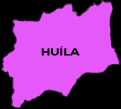
Capital: Lubango
Area: 79.022 km2
Population: 1.078.215 hab.
City Councils: 14 - Quilengues, Lubango, Humpata, Chibia, Chiange, Quipungo, Caluquembe, Caconda, Chicomba, Matala, Jamba, Chipindo, Kuvango
Climate: Tropical, Semi-arid
Agriculture: Varied products
Other products: Industrial products

Capital: Luanda
Area: 2.417.78 km2
Population: 2.494.305 hab.
City Councils: 10 - Cazenga, Ingombota, Kilamba Kiáxi, Malanga, Rangel, Samba, Sambizanga, Cacuaco, Viana
Climate: Tropical
Agriculture: Varied products
Minerals: Mineral Industry
Other products: Fish
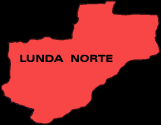
Capital: Lucapa
Area: 103.000 km2
Population: 250.000 hab.
City Councils: 9 - Tchitato, Cambulo, Chitato, Cuilo, Caungula, Cuango, Lubalo, Capenda Camulemba, Xá Muteba
Climate: Tropical
Agriculture: Rice, manioc, corn, palm trees
Minerals: Diamonds
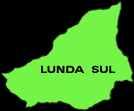
Capital: Saurimo
Area: 77.637 km2
Population: 120.000 hab.
City Councils: 4 - Saurimo, Dala, Muconda, Cacolo
Climate: Tropical
Agriculture: Rice, manioc, corn, vegetables
Minerals: Diamonds, manganese, iron
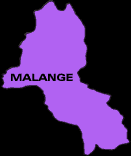
Capital: Malange
Area: 97.602 km2
Population: 700.000 hab.
City Councils: 14 - Massango, Marimba, Calandula, Caombo, Cuda-dia-baza, Cacuzo, Cuaba Nzogo, Quela, Malange, Mucari, Cangadla, Cambundi-Catembo, Luquembo, Quirima
Climate: Tropical
Agriculture: Cotton, manioc, peanut, corn, sunflower, rice, sisal
Minerals: Diamonds, radioactives minerals, copper
Other Products: -
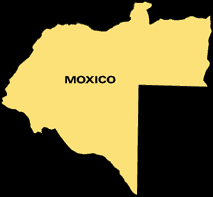
Capital: Luena
Area: 223.023 km2
Population: 230.000 hab.
City Councils: 9 - Moxico, Camanongue, Léua, Camela, Luau, Lucano, Alto Zambeze, Luchazes, Bundas
Climate: Tropical of Altitude
Agriculture: Rice, manioc, corn, peanut, timber
Minerals: Coal, copper, manganese, iron
Other Products: Fish, domestic birds

Capital: Namibe
Area: 57.091 km2
Population: 131.600 a 220.000 hab.
City Councils: 5 - Namibe, Camaculo, Bibala, Virei, Tombua
Climate: Semi Arid and Desert like.
Agriculture: -
Minerals: -
Other Products: Fish, salt

Capital: Cabinda
Area: 7.270 km2
Population: 100.000 hab.
City Councils: 4 - Cabinda, Cacongo, Buco-Zau, Belize
Climate: Equatorial
Agriculture: Coffee, cocoa, palm trees, manioc, corn
Minerals: Petroleum, gold, potassium, uranium
Other Products: Precious timber
 History / Chronology of Cabinda History / Chronology of Cabinda |
1883: Portuguese occupied the Cabinda enclave. The boundaries for present-day Angola were set by European powers at the 1884 Berlin Conference.
1954: Oil explorations began in the Cabinda province.
Holden Roberto founded the first independence movement whose goal was to reunify the Bakongo people who were spread over three countries as a result of colonization. This goal was modified in 1958 to a nationalist orientation. The UPA (Union of Angolan People) became the FNLA (National Front for the Liberation of Angola) in 1962. FNLA was a significant actor in the struggle for independence for Angola.
1956: The MPLA was founded by combining many illegal independence groups. The MPLA called for the repeal of repressive laws, nationalization of certain industries, redistribution of land.
The Cabindan enclave was incorporated into Angola.
1961: Alliance of Mayombe established along with two other separatist groups in the enclave of Cabinda. In 1963, they joined together to form FLEC (Front for the Liberation of the Enclave of Cabinda). This was a separate struggle for independence not related to the struggle engaged by UNITA/FLNA/MPLA for the independence of the whole of Angola from Portugal. Though the majority of the enclave are Bakongo, they are separated geographically and culturally from the Bakongo in Angola proper and show no solidarity with them.
March 1961: FNLA (then the Union of Angolan Peoples) launched attack on Portuguese, but they crushed the peasant attack. As a result, as many as 400,000 Bakongo fled into neighboring Zaire.
This marked the beginning of war of independence. The FNLA was joined by the MPLA (Popular Movement for the Liberation of Angola) in the liberation struggle. MPLA draws support from intellectuals of all ethnic groups and the Mbunda living in and around Luanda. It was led by Agostinho Neto.
1961-1975: Fight for independence involving the FNLA, MPLA, and UNITA against the Portuguese.
1963: Jonas Savimbi broke away from the FNLA to form his own resistance movement UNITA (National Union for the Total Independence of Angola). UNITA draws support largely from the Ovimbundu ethnic group.
1964: MPLA began excursions into the enclave of Cabinda and was met with resistance from the Mayombe peasants whose territory they needed to cross from bases near the Congo frontier, and from FLEC separatists.
10 January 1967: FLEC, following the example of the MPLA, created a government in exile based in the border town of Tshela, Zaire. In the early years of the autonomy movement, Zaire allowed the rebels to use its territory and generally gave them its support.
1968: Oil production began in the Cabinda province. U.S. owned Gulf Oil (later Chevron) owns 49% of the shares in offshore Cabinda blocks. Chevron later withdrew 20% of its Cabgoc interests under pressure from the Reagan administration. Reagan disliked the presence of Cuban troops supporting the Angolan government in Cabinda and therefore pressured Chevron to end its dealings with the "marxist" Angolan government.
1975: War of independence ended. Most Portuguese flee. The MPLA declares all other political parties illegal and begins to use its military power to suppress the other two factions.
February 1975: The MPLA government declared it is ready to negotiate with the separatists in Cabinda. FLEC demands included the disassociation of Cabinda and Angola, a recognition of FLEC as the only Cabinda liberation movement, and formal recognition of the Cabinda people's right to self-determination. FLEC also protested to the U.N. the alleged killing of over 100 students and villagers by MPLA and Portuguese troops.
May 1975: FLEC denounced the agreement of Alvor ending the Angolan liberation movement which gave control of Cabinda to the MPLA government in Angola. FLEC called on the U.N. and O.A.U. to negotiate a solution to Cabinda's desire for independence.
July 1975: Zairean president Mobutu called for a referendum on the future of the Cabinda enclave. Congolese president Henri Lopes concurred stating "Cabinda exists as a reality and is historically and geographically different from Angola." Gabon, Uganda, and Central African Republic had all expressed support for or recognition of FLEC, though the majority of OAU members firmly opposed the Cabindan separatists on the grounds that it would encourage separatists elsewhere.
1 August 1975: FLEC president Luis Ranque Franque declared the territory independent. With MPLA troops in control of the enclave, the declaration had little immediate impact.
1976: The MPLA (marxist government) defeated the other resistance groups and Neto became president. In November, the OAU recognized the MPLA as the legal government of Angola.
May 1976: The MPLA government continued to rely heavily on Cuban troops in the Cabinda enclave. FLEC increased its attacks against Cuban troops. MOLICA (Cabinda Liberation Movement) charged the government with wiping out an entire village in Bucca Zau region using 122mm rockets. Rebels claimed some 45,000 Cabindans fled to Zaire. On 20 May, President Mobutu of Zaire announced the closing of the Zairean border with Cabinda. Zaire and Angola agreed to an end of hostilities.
16 October 1977: FLEC split. The CMLC (Military Command for the Liberation of Cabinda) claimed the task of replacing FLEC and reorganizing the movement on a new democratic foundation.
1979: Neto died, Jose Eduardo dos Santos became president.
27 October 1979: Zaire announced it would ban opposition leaders from Zaire giving them two weeks to leave. Angolan refugees would no longer be allowed to settle along the frontiers with Angola and Cabinda. Estimates suggested 700,000 Angolan refugees live in Zaire.
1979-1984: Each fighting faction drew support from outside nations. The MPLA was traditionally supported by the Soviet Union and Cuba. The FNLA was supported early on by the U.S., Zaire, China and North Korea. UNITA drew support from Tanzania, Zambia and China and later from the U.S. By the late 1970s, the FNLA became a secondary actor.
Approximately 2000 Cuban troops were stationed in Cabinda in the 1970s and 1980s. Zaire withdrew support from FLEC rebels in the late 1970s. FLEC was also plagued by fragmentation. | May 1981: Six men were sentenced to death on charges of belonging to FLEC and of having carried out bomb attacks against strategic economic targets, schools and hospitals in Angola proper. Another four were sentenced to 24 years' imprisonment each.
1983: Luanda agreed to an unofficial amnesty for FLEC guerrillas
and more than 8000 refugees returned to Cabinda.
1984: Attempt at a peaceful solution to the larger conflict became the Lusaka accord. This accord tied Namibian independence from South Africa to the removal of Cuban troops and advisors from Angola. However, the accord failed when the South African government failed to uphold its end of the agreement. By this time, over 500,000 Ovimbundu were considered refugees by the United Nations.
1985: Zaire and Angola agreed not to allow rebels to use the other's territory as bases. In February, a cease-fire was agreed to between the MPLA government and FLEC, but no formal resolution was reached.
August 1988: Agreement between Cuba, South Africa, and Angola on a cease-fire in Angola and Namibia and an end to South African participation in the wars was reached. This opened the way to independence in Namibia and an agreement to withdraw 50,000 Cuban troops from Angola. FLEC existed in little more than name due to fragmentation, Cuban troops in Cabinda and the withdrawal of support from Zaire.
April 1989: An estimated 400,000 Angolans were refugees in neighboring states and another 650,000 were internally displaced.
December 1990: MPLA Congress endorsed the creation of a free-market economy and multiparty system of government, and denounced communism.
March 1991: The government legalized opposition parties. FNLA had essentially become a non-actor, though its exiled leader (Holden Roberto) returned when parties were legalized and was a candidate for president in 1992. UNITA transformed itself into a political movement. In May, the last of the Cuban troops left Angola.
May 1991: Press reported that the newly signed peace agreement effectively ended a bloody 16-year civil war. There were calls for a national election. However, the peace was very tenuous and the country remained tense.
August 1992: Large numbers of refugees in Zaire began trickling back into Angola prior to elections. It was likely that most of these refugees are of the Bakongo ethnic group.
September 29-30, 1992: Angolans wnet to the polls in the first direct elections since independence. 4.8 million voted. Presidential candidates included dos Santos, Savimbi, and Roberto. Separatist feelings were still prominent in the Cabinda province. Polls showed that 91% of registered voters in Angola voted. However, in the Cabinda enclave, only 7-12% of Cabinda's residents voted after being urged to boycott the elections by FLEC. This was interpreted as a referendum for independence on the part of the Cabindans. Oil production in Cabinda provides a vast majority of Angola's foreign earnings, yet Cabinda receives less than 1% of the oil revenue and remains underdeveloped and the people remain poor. The U.S., MPLA and UNITA rejected Cabinda's bid for independence, but the MPLA government appeared ready to negotiate a separate status for Cabinda.
October 1992: Election results brought violence. In the presidential election, 49.7% of the vote went to dos Santos, 40% to Savimbi. MPLA gained 129 of 220 seats in the national assembly. FNLA received 2.5% of the National Assembly seats. The election was proclaimed free and fair by international observers. The majority of demobilized UNITA soldiers returned to arms.
October 30-November 1, 1992: "Three Day War" in Luanda. Evidence suggested more than 10,000 bodies of Ovimbundu and Bakongo lie in mass graves.
November 1992: Savimbi's rebels intensifed fighting. Rebel forces controlled between 60%-70% of the country.
January 1993: Angola in full scale civil war. Aid workers said 10,000-15,000 people have been killed in the past four months. Savimbi launched an offensive in oil-rich northern provinces (including Cabinda). The people of Cabinda province continue to be involved in a separate struggle against the MPLA government for the independence of Cabinda. FLEC is once again active (now FLEC-FAC (Armed Forces of Cabinda)). MPLA is thought to have 15,000 troops in Cabinda.
January 22, 1993: Military, national police and civilians massacred civilians, mostly Bakongo in several cities. Reports suggested this was a deliberate attempt to destroy the Bakongo (ethnic cleansing) who are referred to as "Zaireans" in Angola. The number of dead was thought to be in the thousands (most reports suggest between 4000-6000 dead). Some Ovimbundu were also killed. Following this massacre, known as "Bloody Friday," the government condemned those who took part.
March 1993: FLEC rebels were thought to be in control of much of Cabinda's jungle interior, but the Angolan government still controlled Cabinda City, where one-half of Cabinda's population lives, and the oil wealth.
May 19, 1993: President Clinton announced the U.S. would recognize the government of dos Santos in Angola. In July, the U.S. decided to lift its embargo on nonlethal military supplies to Angola. The MPLA government said this move would put it on a more equal footing with UNITA. Cabinda rebels protested the U.S. recognition that Cabinda is part of Angola.
11 December 1993: Peace talks stalled when rebels accused the government of trying to assassinate Savimbi in a bombing raid on the provincial capital Kuito. An estimated 100,000 have been killed since Savimbi renewed the civil war in October 1992.
March 1994: Talks between Dos Santos and FLEC-FAC were scheduled for the first time in the history of the struggle for the independence of Cabinda. Government troops remained in control of the enclave, though fighting continued. FLEC-FAC had little outside support and few funds, but the tacit support of most of the inhabitants of Cabinda.
June 1994: Government continued on the offensive against UNITA. Attacks reported in Lunda Norte, Malanje and Uige in the North.
August 1994: UNITA accused Luanda government of operating a scorched earth policy in Cabinda. UNITA reported the government killed about 700 villagers in Katabuanga which resulted in hundreds of other Cabindans fleeing to Congo and Zaire.
5 September 1994: UNITA and FLEC joined forces in Cabinda against MPLA. UNITA had briefly joined forces with the MPLA in Cabinda during the 1991-2 cease-fire that was supposed to end the civil war. Cabinda rebels seem to tolerate UNITA rebels when they are useful in their struggle against the government, but FLEC wants UNITA leaders as their government no more than it wants the MPLA government in its territory.
20 November 1994: Lusaka peace accord signed. U.N. Peacekeeping Force was proposed for 1995. South African leader Nelson Mandela played an instrumental role in bringing the MPLA and UNITA together. Peace in Angola, however, is fragile.
February 1995: U.N. voted to send 7000 peace keepers to Angola in May. Defections of UNITA leaders caused alarm as they threatened to return to war. Angola remains tense.
14 February 1995: Savimbi held a congress of UNITA deputies and his basic message to the press was that the war is over. At this congress, Savimbi purged UNITA of those members who refused to return to war after the 1992 elections. By this time, Savimbi has lost outside allies and popular support. Angolans were tired of war and many blamed UNITA more than the government for the recent fighting (e.g. siege of Kuito). Savimbi is now 60 and said he will accept some power-sharing arrangement with the government. The people of Angola were not quite sure if they believed him. Outside observers were a little less skeptical as they saw no other options for Savimbi. Many believed he was a beaten man.
2 March 1995: People and goods could not move freely in Bengo Province, because government troops planted land mines almost everywhere in a flagrant violation of the Lusaka Peace Accord. FAA and the Mining Police clashed in the diamond areas of Lunda Norte province. In Cuanza Norte province on 28 February the UNITA Armed Forces Command denied government claims that UNITA was deploying forces to raid Golungo Alto and Lucala and declared they strictly adhering to the Lusaka Peace Accord.
3 March 1995: About 1,500 FAPLA (People=s Armed Forces for the Liberation of Angola (government of Angola)) soldiers were deployed in the Belize District of Cabinda province to attack UNITA-controlled areas.
30 March 1995: Two rival guerrilla groups went to war against government troops in Northern Angola for control of Cabinda enclave.
28 April 1995: In Cabinda province there were reports of major movements by government troops, including offensive maneuvers and air space violations.
29 September 1995: A cease-fire came into effect between the Angolan Government forces and the rebels of the FLEC-Renewal Front for the Liberation of the Cabinda Enclave-Renewal. The truce is supposed to last for four months.
22 November 1995: The Government and the Cabinda Democratic Front failed to reach an agreement. However the parties agreed to resume talks in the first two weeks of December, when they will certainly sign the accord. The meeting began in Point Noire on 18 and ended 22 November.
3 December 1995: The agreement reached by the Government and the Front for the Liberation of the Cabinda enclave-Cabinda Armed Forces FLEC-FAC this year has not held.
28 December 1995: More than 400 people were killed in Cabinda as a result of clashes between the FLEC-FAC and UNITA over the past two years.
23 January 1996: Cabindan independence fighters said they were holding three mining workers kidnapped in Cabinda.
31 January 1996: Government forces continue to violate the Lusaka Protocol in Cabinda province. On January 30th two helicopters coming from the town of Cabinda overflew at low altitude the areas of Miconje and Otifulu under the control of the UNITA.
February 1996: In February 1995, the Security Council established a peacekeeping operation of 7,000 soldiers. On August 7, 1995 the Security Council extended the peacekeeping mission=s mandate to February 8, 1996 but the presence of the UN has done little to control the civil strife: the UN recorded about 1,500 cease fire violations in 1995. The most tense provinces were Cabinda, Uige and Lunda Sul.
11 April 1996: The Angolan government and the Front for the Liberation of Cabinda agreed to end hostilities and work out a peace plan. The Namibian government played a facilitating role in the Angolan peace process.
11 December 1996: Clashes between Angolan forces and Cabindan separatists in Cabinda resulted in a toll of 29 deaths.
13 December 1996: The Security Council extended the mandate of the UN Angola Verification Mission (UNAVEM III) until 28 February 1997 and approved the Secretary General=s recommendation to resume withdrawal of UNAVEM III formed military units during February 1997.
17 December 1996: UNITA Secretariat in Cabinda Province was worried about the deployment of more government military forces near areas vacated by UNITA military forces, who were confined in Ntoco, Zaire Province.
5 February 1997: Antonio Bento- Bemde was elected the new leader of the Cabinda Enclave Liberation Front-Renewal separatist movement fighting for the independence of Cabinda from Angola.
9 February 1997: A guerrilla group fighting for the independence of Cabinda said it would target western Companies if they did not pull out.
5 March 1997: Rebels of the Cabinda Enclave Liberation Front (FLEC) claimed that they killed 42 Angolan soldiers in combat operations in Cabinda. The Separatist Movement=s officer in charge of education and training activities, Colonel Mauriço Amado Zulu, accused the Angolan authorities of carrying out the summary execution and imprisonment of Cabindan citizens who supported the Cabindan cause. He also denounced the international community for siding with Luanda in the search for a solution to the Cabindan problem. In 1996 the FLEC signed a cease-fire agreement with the Angolan government. The Accord expired at the end of last year.
11 March 1997: Cabinda separatists accused the Angolan Armed Forces (FAA) of having deployed 3,000 men in Cabinda.
26 March 1997: The FLEC-FAC claimed that it killed 27 Angolan soldiers in an attack and that two FLEC-FAC soldiers also perished in the attack in North-Eastern Cabinda.
1 May 1997: Angolan Interior Minister Santana Andre Pitra Petroff chaired a meeting of the Cabinda technical commission in Cabinda on 29 April. The agenda included evaluation of the current political and military situation in the enclave. The commission presented another proposal to the factions to instill new dynamism in the peace process, with the cease-fire as a condition.
21 June 1997: More than 100 people, most of them civilians, were killed in 10 days of fighting between rebel separatists in Angola’s Cabinda enclave and Angolan troops.
11 August 1997: Heavy fighting broke out between separatist rebels and the government forces in Cabinda; the fighting is concentrated in Tandu-Zinze, Buko-Zawu and Belize.
12 October 1997: Congolese troops attacked Angolan forces based in Cabinda; the Congolese forces conducted attacks by air and ground against Angolan army and police detachments in Cabinda. Congo is sheltering around 11,000 Cabinda refugees most in the coastal Pointe-Noire region.
10 December 1997: FLEC-R carried out an attack on civilian vehicles in Cabinda on 6 December. This happened in the area of Chaze, 5 km. from Cabinda.
8 January 1998: Separatists in Cabinda said their forces killed 24 government troops.
24 February 1998: Clashes between Angolan government troops and FLEC troops took place in the Cabinda enclave. The fighting is centred in an area about 70 km from the city of Cabinda but has spread to the capital.
28 March 1998: Separatist rebels of FLEC-FAC attacked 2 civilian vehicles killing one person, injuring 2 and kidnapping 2 civilians.
29 April 1998: Government soldiers beat, tortured and killed unarmed civilians suspected of supporting armed separatists in Cabinda.
6 August 1998: The Angolan authorities closed part of the border in Cabinda province in response to a request by Kinshasa.
12 August 1998: Troops in Cabinda were put on alert to prevent any overspill from the conflict in neighboring Democratic Republic of Congo (DRC).
22 August 1998: Zimbabwe and Angola moved troops to support Congolese president Laurent Kabila in his fight against anti-government rebels, raising the prospect that the war in Africa’s third-largest country will escalate into a regional conflict. Angola massed troops and tanks in Cabinda.
27 August 1998: UNITA prepared to support a rebellion in DRC. Angola wanted to protect Cabinda and wanted a chance to knock out rear bases of its UNITA foes.
4 October 1998: FLEC reported an attack by Angola government troops causing some 200 casualties on both sides.
11 November 1998: FLEC accused the FAA ( Armed Forces of Angola) of shelling regions of Cabinda with heavy artillery fire that killed 7 civilians and injured 19 others.
17 November 1998: The Military Commander of Cabinda, Lt. General Luis Mendes, denied claims that his forces were attacking bases of FLEC-FAC.
28 January 1999: UNITA rebels captured the strategic Northern Angolan town of Mbanza-Congo, threatening the country’s oil production corridor with Cabinda. The Luanda government, confirming the fall of the town near DRC border, said the rebels were trying to set up rear bases for operations in the North-East.
3 February 1999: UNITA captured 500 soldiers. The army recognized that UNITA made decisive advance towards Soyo, Cabinda.
24 March 1999: FLEC-Renewal announced that it was willing to negotiate the release of 2 Portuguese and French citizens kidnapped on 10th March in Cabinda, as long as Cabinda Bishop Dom Paulino Madeca acts as a mediator.
31 March 1999: The Luanda government said it was in favor of resumption of direct negotiations with separatists in Cabinda.
23 April 1999: About 300 women demonstrated peacefully in front of the Cabinda provincial governor’s offices to protest the drafting their sons into the Angolan armed forces. The demonstrators, who demanded to talk with Governor Jose Amaro Tati, were dispersed without violence by police.
7 June 1999: The Angolan army is fighting alongside Congolese troops against both Congolese and UNITA rebels. Several thousand Angolan soldiers are deployed in Congo, particularly in Pointe-Noire, the center of Congo’s oil industry and near Cabinda.
14 June 1999: Four civilians were killed and six were wounded in an armed attack by FLEC in Bulo village, Cabinda province (10km from Congo border).

Capital: Uíge
Area: 56.698 km2
Population: 500.000 hab.
City Council: 15 - Zombo, Quimbele, Damba, Mucaba, Bembe, Songo, Buengas, Sanza Pombo, Ambuila, Uíge, Negage, Puri, Alto Cauale, Quitexe
Climate: Tropical
Agriculture: Coffee, beans, manioc, corn, peanut
Minerals: Copper, silver alloy, cobalto

Capital: M´Banza Kongo
Area: 40.130 km2
Population: 47.000 hab.
City councils: 6 - M´Banza Kongo, Soyo, N´Zeto, Cuimba, Noqui, Tomboco
Climate: Tropical
Agriculture: Manioc, cotton, banana, cocoa, coffee
Minerals: Petroleum
Other products: fish |

